Table of Contents
- Introduction
- Editor’s Choice
- Global Experience Management Market Overview
- Customer Satisfaction Statistics
- Communication Channels for Customer Service and Handling
- Utilization of Various Channels in Customer Experience Management
- Key Attributes of Customer Experience
- Customer Preferences and Priorities
- New Technologies Utilized in Customer Experience Management
- Customer Experience ROI and Conversion
- Key Priorities for Businesses in the Upcoming Years
- Omnichannel & Multichannel Customer Experience
- Benefits of Customer Experience Management
- Challenges in Customer Experience Management
Introduction
According to Customer Experience Management Statistics, Customer Experience Management (CXM) is a comprehensive strategy businesses employ to enhance customer interactions across all touchpoints. It involves understanding customer needs, mapping their journey, personalizing experiences, ensuring consistency across channels, and engaging employees. CXM relies on data analysis, feedback, and continuous improvement.
Its benefits include increased customer loyalty, competitive advantage, and revenue growth, but it also faces challenges like data privacy and keeping up with evolving customer preferences. In essence, CXM is about delivering exceptional experiences throughout the customer journey, contributing to brand reputation and long-term success.
Editor’s Choice
- In 2022, the global customer experience management market had a total value of USD 9,350 million, and it is anticipated to exhibit a robust compound annual growth rate (CAGR) of 15.53% from 2023 to 2032.
- Geographically, North America emerged as the dominant region, capturing a substantial 41.01% of the revenue share in 2021.
- 83% of businesses that prioritize customer satisfaction also see increased revenue.
- In 2022, 54% of customers utilized email as their primary digital channel for seeking customer service, marking it as the most frequently used medium.
- 33% of businesses aim to retain their existing customer base by providing exceptional experiences that foster loyalty.
- As we look ahead to 2025, a significant shift is expected in the strategies of brands, with around 75% planning to incorporate AI-based approaches into their sales tactics.
- Companies that center their operations around customers and prioritize their needs are, in fact, 60% more profitable than those that do not prioritize customers.
- In 2022, the quality of customer experience (CX) declined for 19% of brands, marking the lowest rate in 17 years.
Global Experience Management Market Overview
- In 2022, the global customer experience management market had a total value of USD 9,350 million, and it is anticipated to exhibit a robust compound annual growth rate (CAGR) of 15.53% from 2023 to 2032.
- Analyzing the market by analytical tools, the text analytics segment took the lead in 2021, holding a significant revenue share of more than 41.2% within the customer experience management sector.
- Regarding touchpoint types, the call center segment constituted a notable portion, contributing 33.01% of the overall revenue in 2021.
- Examining deployment methods, the on-premise segment dominated in 2021, accounting for 62.01% of the total revenue.
- Regarding end-use, the IT and telecom sectors held the largest share, exceeding 23.29% in revenue for 2021.
- Geographically, North America emerged as the dominant region, capturing a substantial 41.01% of the revenue share in 2021.
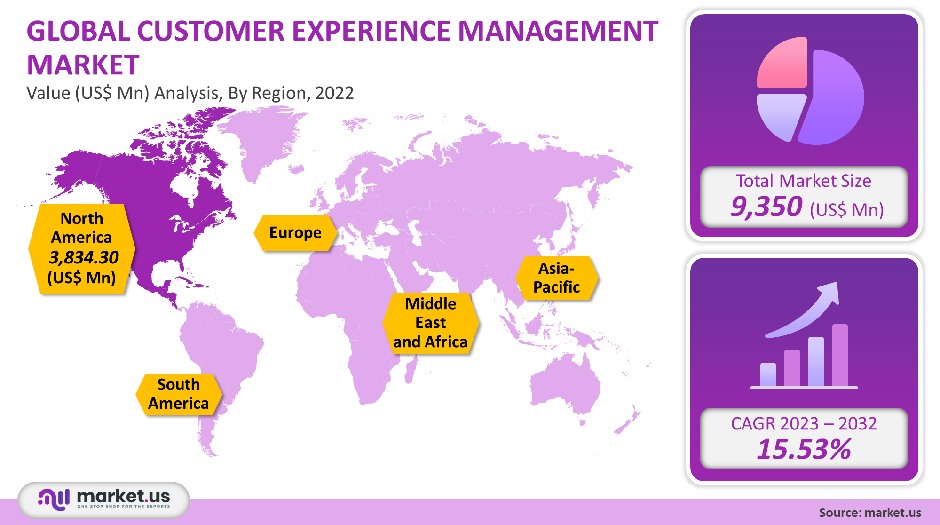
Customer Satisfaction Statistics
- 83% of businesses that prioritize customer satisfaction also see increased revenue.
- For 73% of consumers, having a positive experience plays a significant role in their loyalty to a brand.
- An overwhelming 96% of customers consider customer service a pivotal factor in their decision to remain loyal to a brand.
- 84% of customers prefer brands that treat them as individuals rather than statistics.
Communication Channels for Customer Service and Handling
- In the past year, 54% of customers utilized email as their primary digital channel for seeking customer service, marking it as the most frequently used medium.
- A significant majority, accounting for 62% of customers, prefer interacting with companies via email for customer service.
- Meanwhile, 48% favor phone use, 42% opt for live chat, and 36% choose “Contact Us” forms.
- Among individuals aged 18-44, over 65% rely on mobile devices to seek customer service on multiple monthly occasions.
- Regarding customer service via social media, 65% of those aged 18-34 view it as an effective channel, while this figure drops to 75% for those aged 55 and above.
Utilization of Various Channels in Customer Experience Management
- In Customer Experience Management, various communication channels are pivotal for service teams and customers.
- Email is a widely utilized channel, with 95% of service teams and 98% of customers actively engaging through this medium.
- Phone calls also hold a prominent position, with 95% of service teams and 93% of customers using this channel for interactions.
- In-person interactions remain significant, with 89% of service teams and 94% of customers valuing face-to-face encounters.
- Social media plays a crucial role, with 72% of service teams and 71% of customers using these platforms for communication.
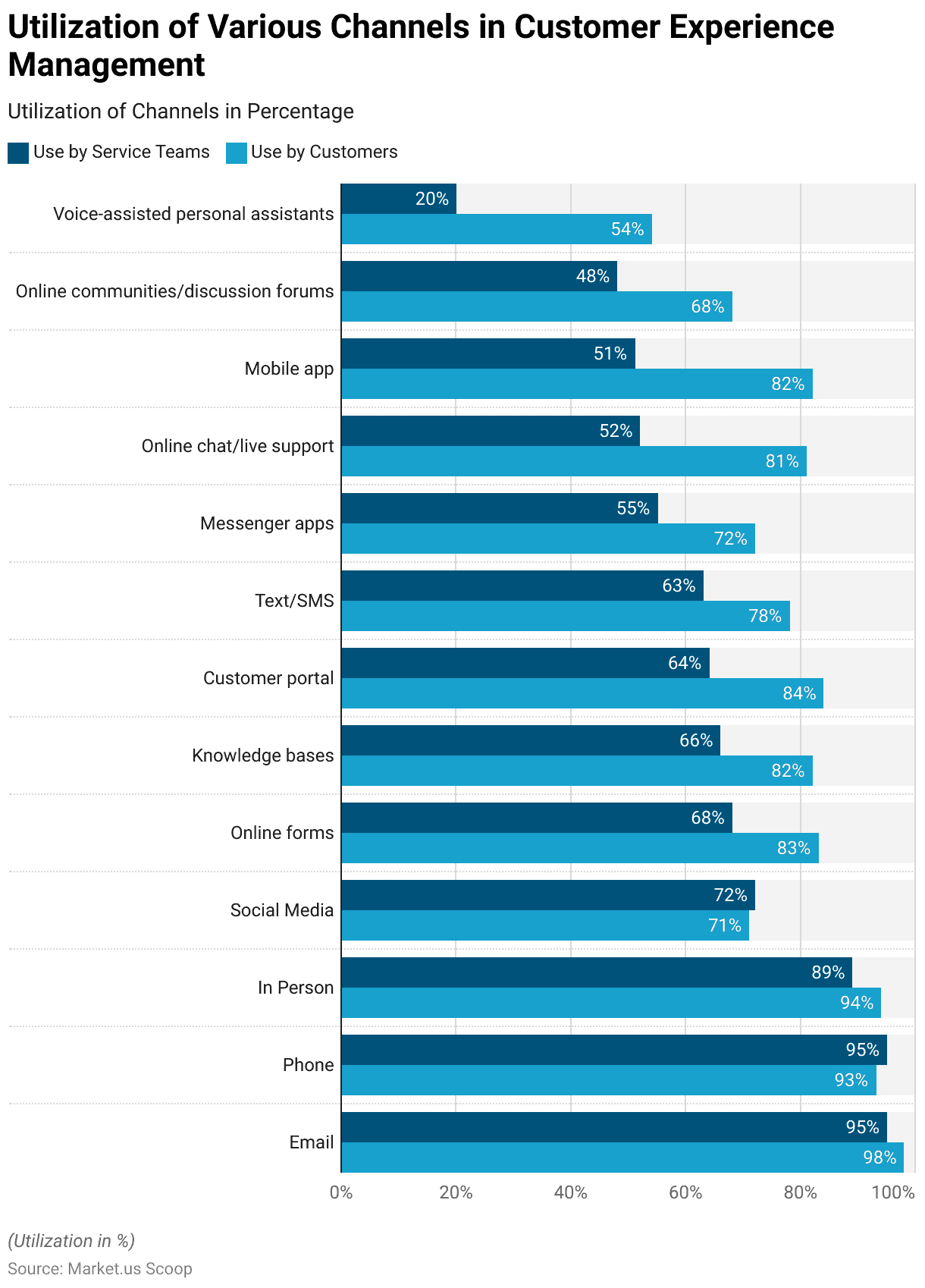
Key Attributes of Customer Experience
- The key attributes that customers value in their overall experience with a business are diverse, with different percentages indicating their significance.
- Notably, fast response times are the most crucial, with 75% of customers emphasizing receiving quick answers and assistance.
- Consistency across various communication channels also holds significant weight, with 55% valuing a seamless and uniform experience.
- Knowledgeable staff members are highly regarded, with 52% considering their expertise crucial.
- Clear, consistent messaging is essential for 46% of customers while having a person to speak with directly matters to 37%.
- Multiple contact points are valued by 28% of customers, and easy-to-use service tools are significant by 23%.
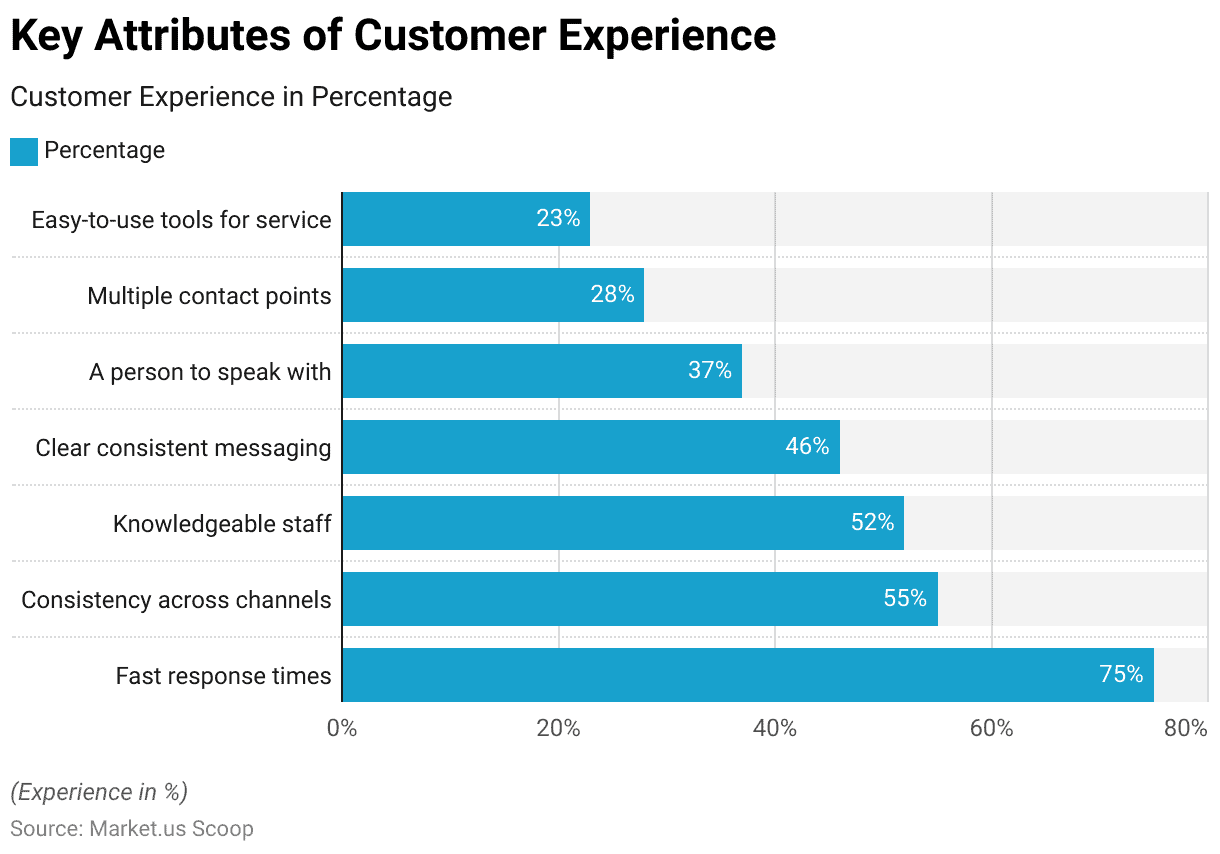
Reasons Why Businesses Are Investing in Customer Experience
- Businesses have compelling reasons to invest in enhancing their customer experience.
- A significant driver for such investments is the desire to improve cross-selling and up-selling opportunities, with 42% of businesses recognizing the potential for increased sales and revenue generation through a positive customer experience.
- Additionally, focusing on customer retention is crucial, as 33% of businesses aim to retain their existing customer base by providing exceptional experiences that foster loyalty.
- Moreover, 32% of businesses are committed to improving overall customer satisfaction, understanding that satisfied customers are likelier to remain loyal and recommend their products or services to others.
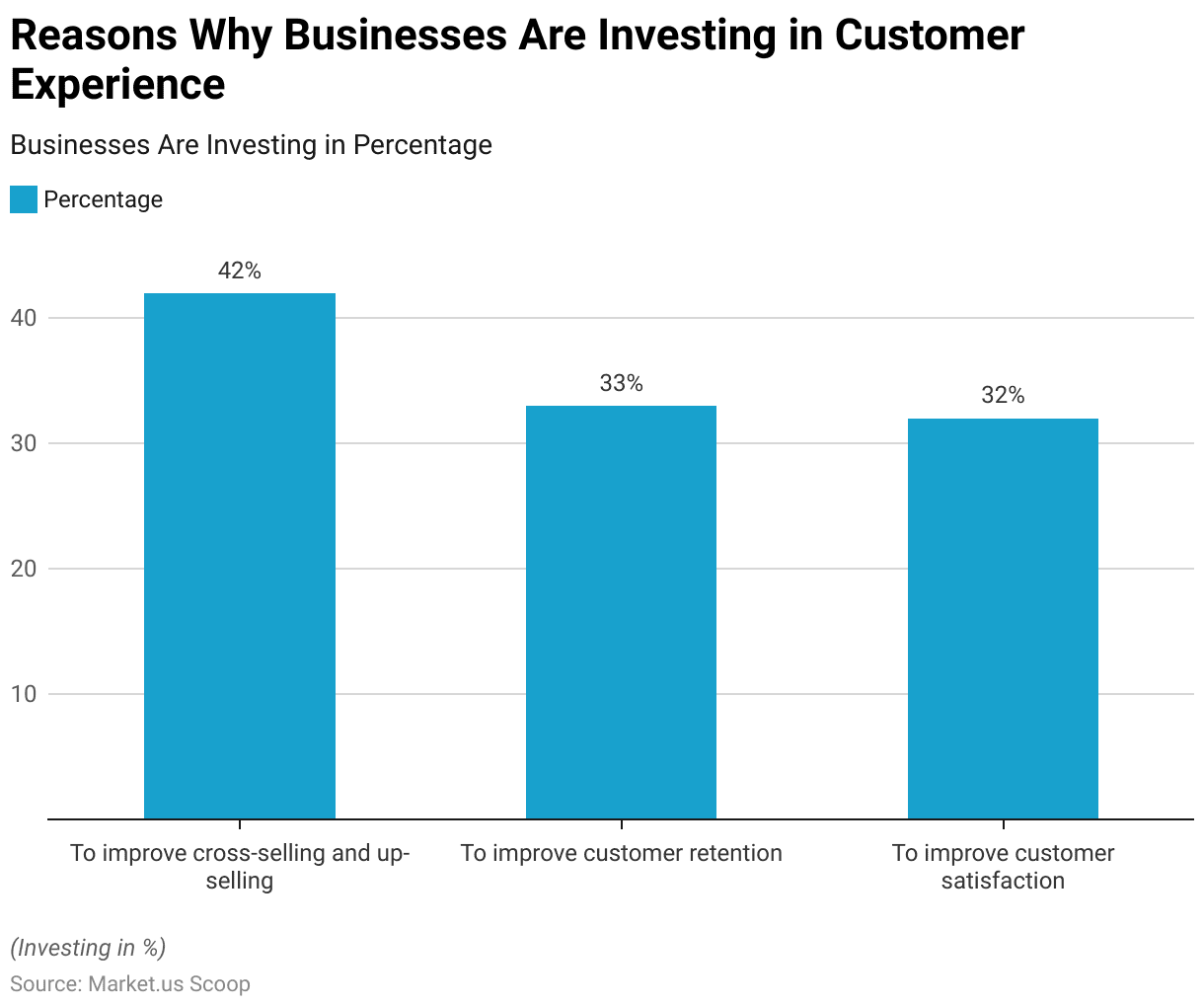
Customer Preferences and Priorities
- On average, customers utilize nine different contact points to interact with businesses, with 60% occurring digitally.
- A significant majority, close to 80% of consumers, prefer phone interactions as their primary choice for customer service.
- When it comes to making a purchase, 18% of consumers consider free shipping to be the most crucial factor.
- The ability to seamlessly transition between different communication channels is desired by 73% of consumers.
- 94% of customers regard video support as a positive and valuable experience.
New Technologies Utilized in Customer Experience Management
- As we look ahead to 2025, a significant shift is expected in the strategies of brands, with around 75% planning to incorporate AI-based approaches into their sales tactics.
- Leadership across industries widely acknowledges the transformative potential of AI, with a resounding 94% recognizing its ability to enhance customer self-service.
- For customers, the digital realm is their preferred arena, with 57% opting for digital channels when engaging with companies.
- Contact centers, too, are witnessing a shift in priorities, as 70% of consumers emphasize the significance of investing in agent training over introducing additional channels like chatbots.
- Notably, 47% of consumers prefer websites equipped with chatbots, and nearly half, at 48%, are comfortable with automated bot interactions.
- There’s a growing desire among customers to engage in interactive conversations, with 90% expressing a strong wish to respond within messaging systems to seek information and ask questions.
Customer Experience ROI and Conversion
- Companies that excel in delivering exceptional customer experiences achieve sales growth rates that outpace the market average by 4-8%.
- This heightened success can be attributed to superior customer experiences cultivating stronger customer loyalty, transforming them into enthusiastic advocates with a lifetime value ranging from 6 to 14 times higher.
- The cost dynamics of customer acquisition versus retention can vary significantly by industry, with the expense of acquiring a new customer often ranging from five to twenty-five times higher than retaining an existing one.
- Companies that utilize effective tools such as customer journey maps experience revenue growth of up to 10-15% and reduce their service costs by 15-20%.
- Furthermore, 86% of respondents express a willingness to pay a premium for a positive customer experience.
Key Priorities for Businesses in the Upcoming Years
- In the coming five years, businesses have set their sights on key priorities, with customer experience emerging as the foremost focus, garnering the attention of 45.9% of companies.
- Ensuring a top-notch customer experience is paramount in their strategies.
- Pricing also holds significance, with 20.5% of businesses directing their efforts toward this aspect, recognizing its importance in the competitive landscape.
- Product development remains a key concern for 33.6% of companies as they strive to innovate and offer compelling offerings to meet evolving customer demands.
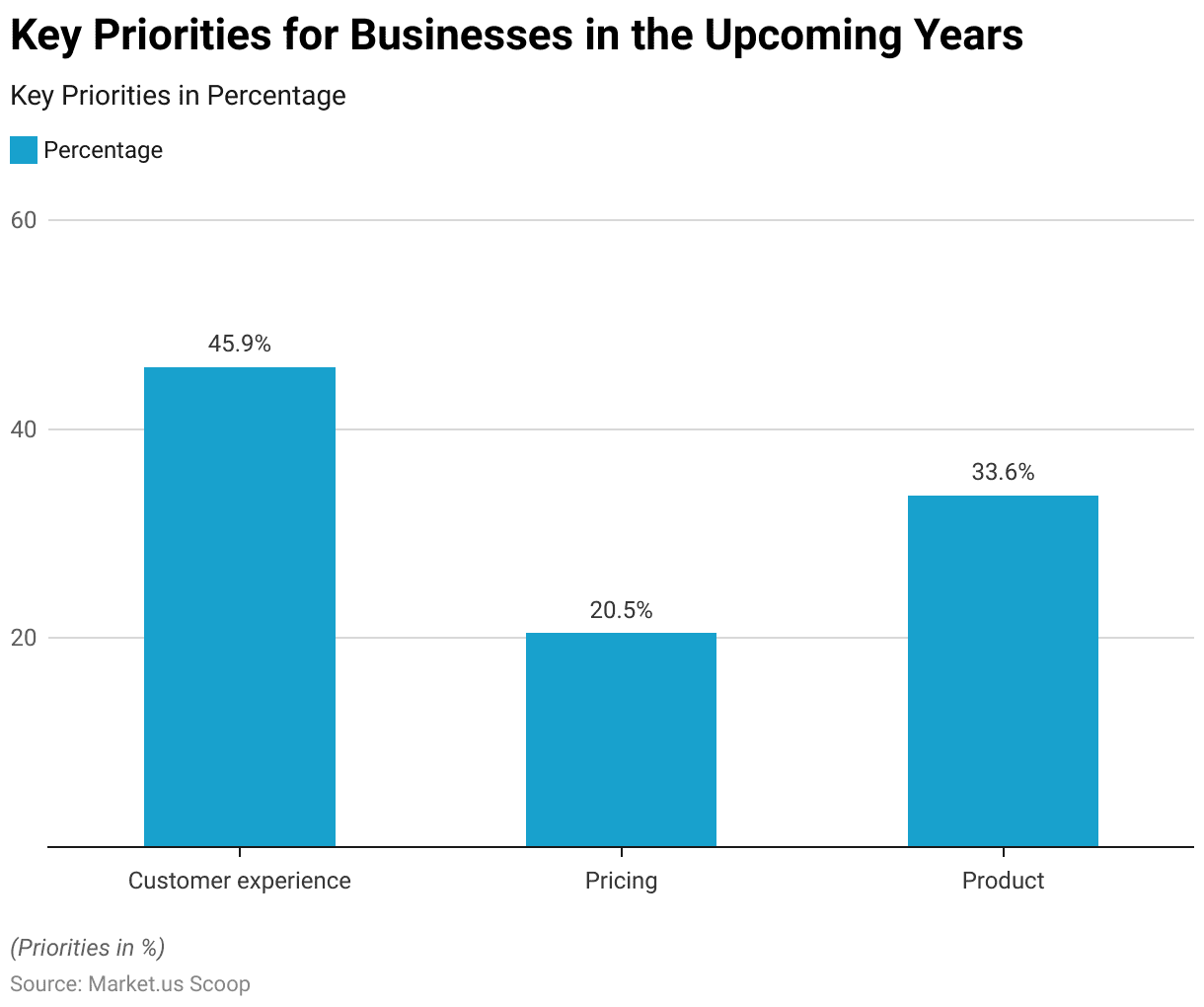
Omnichannel & Multichannel Customer Experience
- A majority of individuals, totaling 60%, express a preference for using email for their service requests.
- In comparison, 58% favor phone communication, 48% opt for live chat, 24% choose SMS/text, and 18% lean towards social media when seeking assistance with simple service inquiries.
- An outstanding customer experience, defined by 28% of respondents, encompasses a range of communication options.
- Companies implementing top-tier omnichannel customer engagement strategies have witnessed impressive results, including 10% year-on-year growth, a 10% increase in average order value, and a remarkable 25% surge in close rates.
- Remarkably, only 8% of companies report seamlessly integrating all their communication channels, with a substantial 70% having few or no connected channels, significantly limiting their insight into customer journeys and preferences.
Benefits of Customer Experience Management
- When businesses prioritize customer satisfaction, 83% also observe an increase in their revenue.
- Brands that provide outstanding customer experiences generate an impressive 5.7 times more revenue than their competitors, who fall short in this aspect.
- For 73% of consumers, having a positive experience is crucial in influencing their brand loyalty.
- Companies that center their operations around customers and prioritize their needs are, in fact, 60% more profitable than those that do not prioritize customers.
- Loyal customers show a strong inclination to make repeat purchases, being five times more likely to do so, and they are also four times more likely to recommend the company to their friends.
Challenges in Customer Experience Management
- In 2022, the quality of customer experience (CX) declined for 19% of brands, marking the lowest rate in 17 years.
- During the same year, 3% of U.S. companies were truly customer-focused, a 7% decrease from the previous year.
- It’s worth noting that 39% of consumers exhibited reduced patience levels compared to pre-pandemic times.
- Additionally, 54% of consumers feel that brands often neglect customer service.
- Nearly half, or 49% of customers, reported having more negative customer service encounters in the past year than in the preceding year.
- Moreover, 56% of consumers believe that many companies treat them merely as numbers, lacking a personalized touch.
Discuss your needs with our analyst
Please share your requirements with more details so our analyst can check if they can solve your problem(s)



